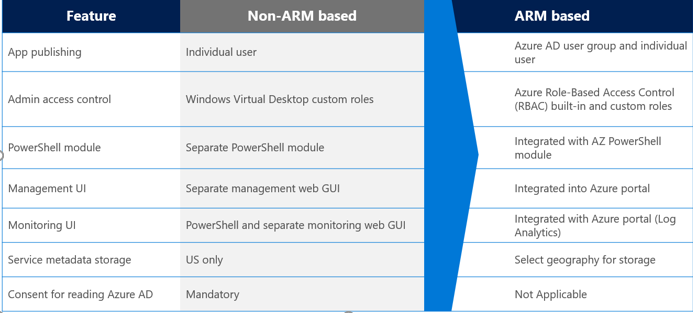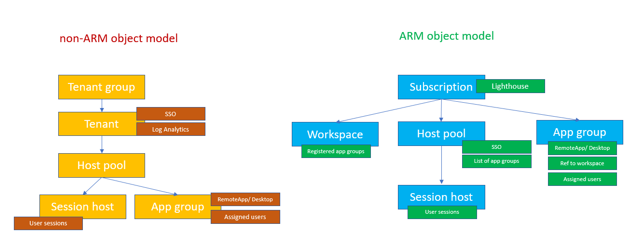Azure Virtual Desktop (AVD) is a comprehensive desktop and app virtualization service running in the Azure cloud. It comprises the Windows desktops and apps you deliver to users and the management solution, which is hosted as a service on Azure by Microsoft. Desktops and apps can be deployed on virtual machines (VMs) in any Azure region, and the management solution and data for these VMs will reside in the United States. This may result in data transfer to the United States.
Windows Virtual Desktop on Azure:
- Set up a multi-session Windows 10 deployment that delivers a full Windows 10 with scalability
- Virtualize Microsoft 365 Apps for enterprise and optimize it to run in multi-user virtual scenarios
- Provide Windows 7 virtual desktops with free Extended Security Updates
- Bring your existing Remote Desktop Services (RDS) and Windows Server desktops and apps to any computer
- Virtualize both desktops and apps
- Manage Windows 10, Windows Server, and Windows 7 desktops and apps with a unified management experience
WVD Management Control Plane
Windows Virtual Desktop service is a PaaS offering from Microsoft, architecture is similar to Windows Server Remote Desktop Services. Microsoft manages the infrastructure and brokering components, while Diageo manage their own desktop host virtual machines (VMs), data, and clients.
Click here to know more about WVD Management Control Plane and User Connection flow
Windows Virtual Desktop Environment structure – Click here
Requirements
There are a few things you need to set up Windows Virtual Desktop and successfully connect your users to their Windows desktops and applications.
We plan to add support for the following OSes, so make sure you have the appropriate licenses for your users based on the desktop and apps you plan to deploy:
| OS | Required license |
| Windows 10 Enterprise multi-session or Windows 10 Enterprise | Microsoft 365 E3, E5, A3, A5, F3, Business Premium Windows E3, E5, A3, A5 |
| Windows 7 Enterprise | Microsoft 365 E3, E5, A3, A5, F3, Business Premium Windows E3, E5, A3, A5 |
| Windows Server 2012 R2, 2016, 2019 | RDS Client Access License (CAL) with Software Assurance |
Your infrastructure needs the following things to support Windows Virtual Desktop:
- An Azure Active Directory
- A Windows Server Active Directory in sync with Azure Active Directory. You can configure this with one of the following:
- Azure AD Connect (for hybrid organizations)
- Azure AD Domain Services (for hybrid or cloud organizations)
- An Azure subscription that contains a virtual network that either contains or is connected to the Windows Server Active Directory
The Azure virtual machines you create for Windows Virtual Desktop must be:
- Standard domain-joined or Hybrid AD-joined. Virtual machines can’t be Azure AD-joined.
- Running one of the following supported OS images.
WVD Reference Architectures: Click here
Windows Virtual Desktop Step by step implementation guide (Non ARM and ARM model) – Click here to read more details
Differences between WVD non-ARM and ARM
The new Management portal integration is completely build on ARM, which means that permissions can be managed via role-based access control (RBAC). All the deployment objects of WVD e.g. host pools, workspaces etc are objects within your Azure subscription. This makes it easier to manage and automate your environment.
See below the most important differences and changes of WVD non-ARM current and ARM future also called the 2020 spring release!


History of Updates
- In September 2018, Microsoft introduced Windows Virtual Desktop as an end-to-end virtualization solution that was the only solution to offer multi-user Windows 10, and free ESU for virtualized Windows 7 desktops.
- In November 2018, Microsoft acquired FSLogix to facilitate the adoption of WVD and support hybrid implementation scenarios.
- In March 2019, the public preview of Windows Virtual Desktop was made available for Microsoft to work with more customers to improve the solution.
- In August 2019, WVD became a feature complete service and advanced into the final phase of for General Availability.
- In September 2019, Microsoft made WVD generally available for worldwide customers. In April 2020, Microsoft announced the Public Preview of the Windows Virtual Desktop Spring Update of 2020 major release. As a part of the Windows Virtual Desktop Spring 2020 update, WVD has now been integrated into Azure Resource Manager thereby reducing the dependence on PowerShell, external tools, and web apps for resource management. Additionally, it is now possible to redirect Microsoft Teams audio and video calls using WVD which reduces latency and improves call experience.
Knowledge Base References: